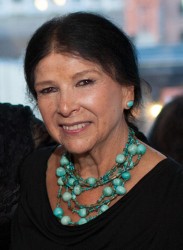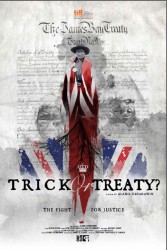Article Origin
Volume
Issue
Year
Alanis Obomsawin’s latest endeavour is making its world debut at the Toronto International Film Festival as the first work by an Indigenous filmmaker to be included in TIFF’s Masters program.
“I’m very honoured. I think it’s wonderful,” said Obomsawin, who is the writer/director for Trick or Treaty?
“I always think the more people seeing the film, the better place we get. It’s helpful to all our people and especially the ones whose story it is about.”
“It’s a prestigious program within the festival. The film will qualify for critics and audience awards,” said National Film Board of Canada publicist Jennifer Mair. Trick or Treaty? is a NFB production.
TIFF calls the Masters program “a line-up of the most inspiring, audacious, and original filmmakers working in cinema today.” The films being screened are receiving their Canadian, North American or world premiere.
Trick or Treaty? is an 84-minute documentary film centred on the James Bay Treaty (Treaty No. 9). But while it chronicles the speaking engagements of Dr. Stan Louttit, grand chief of the Mushkegowuk Council, whose grandfather Andrew Wesley is one of the signatories to Treaty No. 9, it also raises questions generally about treaties and unfulfilled promises.
Obomsawin includes the 44-day hunger strike undertaken by Attawapiskat Chief Theresa Spence; the birth of the Idle No More movement; and a group of six young people, led by David Kawapi, who marched 1,600 km from Whapmagoostui on Hudson’s Bay to Ottawa in March 2013.
Trick or Treaty? couldn’t be more timely in its release as it follows the Supreme Court’s decision on the Grassy Narrows First Nation, which says, under Treaty 3 Ontario has the power to take up lands in the Keewatin area and limit the harvesting rights under the treaty and does not need permission from the federal government to do so. Following the decision, Ontario Regional Chief Stan Beardy said in a statement, “The question that is being missed today is how did Canada and Ontario come to say they have decision-making power over First Nations’ homelands in the first place?”
That is the very question Trick or Treaty? examines. The documentary proposes there are two treaties: one which is oral and understood by the First Nations leaders and one which was written.
“I have a lot of interest in treaties and how they got people to sign treaties,” said Obomsawin. “It’s really terrible because they were really playing on the naivetÈ of the people.”
Obomsawin says she would like Trick or Treaty? to be seen by both Indigenous and non-Indigenous people and make its way into the education system.
“The message is that there was injustice and that they were playing on words with people and that justice should be made because they’re still affected by the fact that this treaty was signed the way it was,” said Obomsawin. “They should have rights to their natural resources and their land and they should be part of decision-making when it comes to any kind of development of resources.”
Obomsawin is proud of the title her work has garnered her as an activist filmmaker. In 1967, NFB producers Joe Koenig and Bob Verrall invited Obomsawin to join as a consultant for a film about Indigenous people. Her passion to tell her people’s story and discovering how wrapped up that story is in treaty is what inspired her to get behind the camera.
Trick or Treaty? is one in a series of five films that Obomsawin has been working on since 2010. Trick or Treaty? is preceded by The People of the Kattawapiskak River (2012), which looks at the housing crisis faced by the Cree of James Bay, and Hi-Ho Mistahey!, which had its world premiere at TIFF last year and was nominated for the Canadian Screen Award for Best Feature Length Documentary (2014).
Obomsawin says the footage shot for Trick or Treaty? was unique to that film and not much ended up on the cutting room floor. There is bonus footage for the film as well.
Obomsawin says she is pleased with the final product.
“This is a lot of work and a lot of research, and it’s working with people and making sure the truth is there,” she said.
Trick or Treaty? will receive its first screening on Sept. 5, the second day of TIFF. It will be shown in the TIFF Bell Lightbox. TIFF runs from Sept. 4 to Sept. 14. It runs again on Sept. 6 at the AGO Jackman Hall.
- 1857 views


